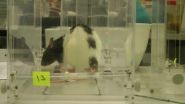(Press-News.org) For some cigarette smokers, strategies to aid quitting work well, while for many others no method seems to work. Researchers have now identified an aspect of brain activity that helps to predict the effectiveness of a reward-based strategy as motivation to quit smoking.
The researchers observed the brains of nicotine-deprived smokers with functional magnetic resonance imaging (fMRI) and found that those who exhibited the weakest response to rewards were also the least willing to refrain from smoking, even when offered money to do so.
"We believe that our findings may help to explain why some smokers find it so difficult to quit smoking," said Stephen J. Wilson, assistant professor of psychology, Penn State. "Namely, potential sources of reinforcement for giving up smoking -- for example, the prospect of saving money or improving health -- may hold less value for some individuals and, accordingly, have less impact on their behavior."
The researchers recruited 44 smokers to examine striatal response to monetary reward in those expecting to smoke and in those who were not, and the subsequent willingness of the smokers to forego a cigarette in an effort to earn more money.
"The striatum is part of the so-called reward system in the brain," said Wilson. "It is the area of the brain that is important for motivation and goal-directed behavior -- functions highly relevant to addiction."
The participants, who were between the ages of 18 and 45, all reported that they smoked at least 10 cigarettes per day for the past 12 months. They were instructed to abstain from smoking and from using any products containing nicotine for 12 hours prior to arriving for the experiment.
Each participant spent time in an fMRI scanner while playing a card-guessing game with the potential to win money. The participants were informed that they would have to wait approximately two hours, until the experiment was over, to smoke a cigarette. Partway through the card-guessing task, half of the participants were informed that there had been a mistake, and they would be allowed to smoke during a 50-minute break that would occur in another 16 minutes.
However, when the time came for the cigarette break, the participant was told that for every 5 minutes he or she did not smoke, he or she would receive $1 -- with the potential to earn up to $10.
Wilson and his colleagues reported in a recent issue of Cognitive, Affective and Behavioral Neuroscience that they found that smokers who could not resist the temptation to smoke also showed weaker responses in the ventral striatum when offered monetary rewards while in the fMRI.
"Our results suggest that it may be possible to identify individuals prospectively by measuring how their brains respond to rewards, an observation that has significant conceptual and clinical implications," said Wilson. "For example, particularly 'at-risk' smokers could potentially be identified prior to a quit attempt and be provided with special interventions designed to increase their chances for success."
INFORMATION:
Working with Wilson were Patricia S. Grigson, professor of neural and behavioral sciences, Penn State College of Medicine; R. Ross MacLean, Shannon L. Henry and Travis T. Nichols, graduate students, all at Penn State; Mauricio R. Delgado, associate professor of psychology, Rutgers University; and Sherry A. McKee, associate professor of psychiatry, Yale University School of Medicine.
The National Institute on Drug Abuse and the Eunice Kennedy Shriver National Institute of Child Health and Human Development of the National Institutes of Health, as well as the Huck Institutes of the Life Sciences at Penn State supported this research.
Neural reward response may demonstrate why quitting smoking is harder for some
2014-06-12
ELSE PRESS RELEASES FROM THIS DATE:
Proteins causing daytime sleepiness tied to bone formation, target for osteoporosis
2014-06-12
DALLAS – June 12, 2014 – Orexin proteins, which are blamed for spontaneous daytime sleepiness, also play a crucial role in bone formation, according to findings by UT Southwestern Medical Center researchers. The findings could potentially give rise to new treatments for osteoporosis, the researchers say.
Orexins are a type of protein used by nerve cells to communicate with each other. Since their discovery at UT Southwestern more than 15 years ago, they have been found to regulate a number of behaviors, including arousal, appetite, reward, energy expenditure, and wakefulness. ...
Long-range tunneling of quantum particles
2014-06-12
This news release is available in German. One of the most remarkable consequences of the rules in quantum mechanics is the capability of a quantum particle to penetrate through a potential barrier even though its energy would not allow for the corresponding classical trajectory. This is known as the quantum tunnel effect and manifests itself in a multitude of well-known phenomena. For example, it explains nuclear radioactive decay, fusion reactions in the interior of stars, and electron transport through quantum dots. Tunneling also is at the heart of many technical ...
Vast genetic diversity among Mexicans found in large-scale study
2014-06-12
The first large-scale, comprehensive analysis of the genomic diversity of Mexico — led by researchers at the Stanford University School of Medicine, the University of California-San Francisco and the Mexican National Institute of Genomic Medicine — has identified a dazzling mosaic of genotypes and population substructures across the country.
Some groups are as genetically different from one another as Europeans are from East Asians.
The study, which will be published June 13 in Science, soundly refutes the current practice of lumping together Mexicans or Latinos as ...
Broad Institute, MGH researchers chart cellular complexity of brain tumors
2014-06-12
Scientists from the Broad Institute and Massachusetts General Hospital (MGH) have conducted a first-of-its-kind study that characterizes the cellular diversity within glioblastoma tumors from patients. The study, which looked at the expression of thousands of genes in individual cells from patient tumors, revealed that the cellular makeup of each tumor is more heterogeneous than previously suspected. The findings, which appear online in Science Express, will help guide future investigations into potential treatments for this devastating disease.
This is the first time ...
Mexican genetics study reveals huge variation in ancestry
2014-06-12
In the most comprehensive genetic study of the Mexican population to date, researchers from UC San Francisco and Stanford University, along with Mexico's National Institute of Genomic Medicine (INMEGEN), have identified tremendous genetic diversity, reflecting thousands of years of separation among local populations and shedding light on a range of confounding aspects of Latino health.
The study, which documented nearly 1 million genetic variants among more than 1,000 individuals, unveiled genetic differences as extensive as the variations between some Europeans and Asians, ...
Father's age influences rate of evolution
2014-06-12
The offspring of chimpanzees inherit 90% of new mutations from their father, and just 10% from their mother, a finding which demonstrates how mutation differs between humans and our closest living relatives, and emphasises the importance of father's age on evolution.
Published today in Science, researchers from the Wellcome Trust Centre for Human Genetics and the Biomedical Primate research Centre in the Netherlands looked at whether, in chimpanzees, there was a heightened risk of fathers passing on mutations to their children compared to humans.
In humans, each individual ...
New evidence for oceans of water deep in the Earth
2014-06-12
Researchers from Northwestern University and the University of New Mexico report evidence for potentially oceans worth of water deep beneath the United States. Though not in the familiar liquid form -- the ingredients for water are bound up in rock deep in the Earth's mantle -- the discovery may represent the planet's largest water reservoir.
The presence of liquid water on the surface is what makes our "blue planet" habitable, and scientists have long been trying to figure out just how much water may be cycling between Earth's surface and interior reservoirs through ...
With the right rehabilitation, paralyzed rats learn to grip again
2014-06-12
VIDEO:
This video depicts Restored grasping after immunotherapy and rehabilitative training.
Click here for more information.
Only if the timing, dosage and kind of rehabilitation are right can motor functions make an almost full recovery after a large stroke. Rats that were paralyzed down one side by a stroke almost managed to regain their motor functions fully if they were given the ideal combination of rehabilitative training and substances that boosted the growth of nerve fibers. ...
Unexpected origin for important parts of the nervous system
2014-06-12
A new study from Karolinska Institutet in Sweden shows that a part of the nervous system, the parasympathetic nervous system, is formed in a way that is different from what researchers previously believed. In this study, which is published in the journal Science, a new phenomenon is investigated within the field of developmental biology, and the findings may lead to new medical treatments for congenital disorders of the nervous system.
Almost all of the body's functions are controlled by the autonomous, involuntary nervous system, for example the heart and blood vessels, ...
Scientists discover link between climate change and ocean currents over 6 million years
2014-06-12
Scientists have discovered a relationship between climate change and ocean currents over the past six million years after analysing an area of the Atlantic near the Strait of Gibraltar, according to research published today (Friday, 13 June) in the journal Science.
An expedition of scientists, jointly led by Dr Javier Hernandez-Molina, from the Department of Earth Sciences at Royal Holloway, University of London, examined core samples from the seabed off the coast of Spain and Portugal which provided proof of shifts of climate change over millions of years.
The team ...




